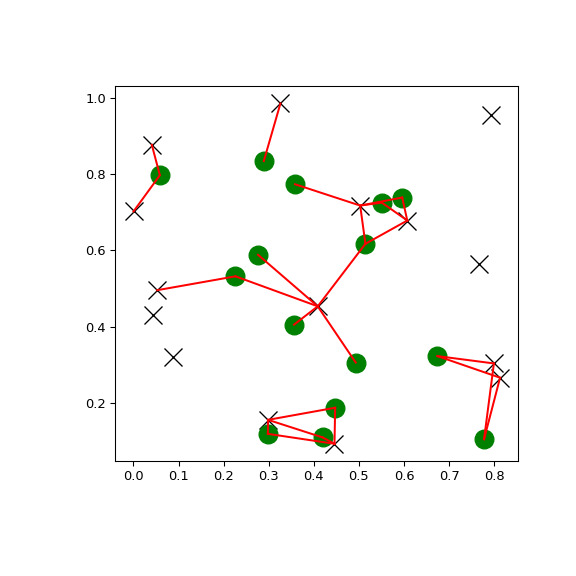本文簡要介紹 python 語言中 scipy.spatial.KDTree.query_ball_tree 的用法。
用法:
KDTree.query_ball_tree(other, r, p=2.0, eps=0)#找到 self 和 other 之間距離最大為 r 的所有點對。
- other: KDTree 實例
包含要搜索的點的樹。
- r: 浮點數
最大距離,必須為正。
- p: 浮點數,可選
使用哪個 Minkowski 範數。p必須滿足條件
1 <= p <= infinity.- eps: 浮點數,可選
近似搜索。如果最近的點比樹的分支更遠,則不會探索樹的分支
r/(1+eps), 如果分支的最遠點接近於r * (1+eps).每股收益必須是非負的。
- results: 列表列表
對於這棵樹的每個元素
self.data[i],results[i]是其在other.data中的鄰居的索引列表。
參數 ::
返回 ::
例子:
您可以搜索距離內兩個kd-trees之間的所有點對:
>>> import matplotlib.pyplot as plt >>> import numpy as np >>> from scipy.spatial import KDTree >>> rng = np.random.default_rng() >>> points1 = rng.random((15, 2)) >>> points2 = rng.random((15, 2)) >>> plt.figure(figsize=(6, 6)) >>> plt.plot(points1[:, 0], points1[:, 1], "xk", markersize=14) >>> plt.plot(points2[:, 0], points2[:, 1], "og", markersize=14) >>> kd_tree1 = KDTree(points1) >>> kd_tree2 = KDTree(points2) >>> indexes = kd_tree1.query_ball_tree(kd_tree2, r=0.2) >>> for i in range(len(indexes)): ... for j in indexes[i]: ... plt.plot([points1[i, 0], points2[j, 0]], ... [points1[i, 1], points2[j, 1]], "-r") >>> plt.show()
相關用法
- Python SciPy KDTree.query_ball_point用法及代碼示例
- Python SciPy KDTree.query_pairs用法及代碼示例
- Python SciPy KDTree.query用法及代碼示例
- Python SciPy KDTree.sparse_distance_matrix用法及代碼示例
- Python SciPy KDTree.count_neighbors用法及代碼示例
- Python SciPy KroghInterpolator.derivatives用法及代碼示例
- Python SciPy interpolate.make_interp_spline用法及代碼示例
- Python SciPy stats.anderson用法及代碼示例
- Python SciPy ClusterNode.pre_order用法及代碼示例
- Python SciPy stats.iqr用法及代碼示例
- Python SciPy FortranFile.read_record用法及代碼示例
- Python SciPy ndimage.correlate用法及代碼示例
- Python SciPy special.exp1用法及代碼示例
- Python SciPy special.expn用法及代碼示例
- Python SciPy signal.czt_points用法及代碼示例
- Python SciPy interpolate.krogh_interpolate用法及代碼示例
- Python SciPy ndimage.morphological_gradient用法及代碼示例
- Python SciPy distance.sokalmichener用法及代碼示例
- Python SciPy linalg.eigvalsh_tridiagonal用法及代碼示例
- Python SciPy linalg.cdf2rdf用法及代碼示例
- Python SciPy csc_array.diagonal用法及代碼示例
- Python SciPy fft.idctn用法及代碼示例
- Python SciPy linalg.LaplacianNd用法及代碼示例
- Python SciPy linalg.solve_circulant用法及代碼示例
- Python SciPy hierarchy.ward用法及代碼示例
注:本文由純淨天空篩選整理自scipy.org大神的英文原創作品 scipy.spatial.KDTree.query_ball_tree。非經特殊聲明,原始代碼版權歸原作者所有,本譯文未經允許或授權,請勿轉載或複製。
